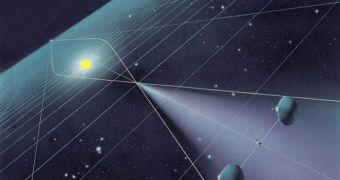In a recent issue of the scientific journal Acta Astronautica, experts proposed we use our Sun as a communications device. Harnessing its gravitational power could enable us to contact and establish a dialog with extraterrestrial civilizations, they added.
Granted, the only issue with this plan is that no one yet knows how this can be done. But some suggest that using the force of gravity the star generates could enable us to construct a giant telescope.
With this device, we would become capable of instantly sending and received magnified signals from distant civilizations, which may be using similar techniques to search for other intelligent lifeforms.
Under the auspices of the theory on general relativity, developed by famed physicist Albert Einstein, the Sun is capable of distorting the fabric of space-time around it, which generates gravity.
If this is true, then this warping also affects light, which gets distorted while passing around the star as if it's going through a lens. Considering that this is true, then placing a detector in the lens' focal point would enable us to see an extremely-magnified image.
While the plan works well in theory, and could be applied in real-life as well, there is as usual a snag. The nearest focal point as the one required for the plan to work is located some 550 astronomical units.
An AU is equivalent to the mean distance between the Sun and the Earth, or about 93 million miles. The fastest spacecraft ever built, the NASA New Horizons, has been traveling for nearly five years, and only managed to cover 18.5 AU.
A basic calculation shows it would take around 150 years (give or take a decade or two) for a detector to make its way to the theoretical focal point, Space reports.
Granted, the advantages such an achievement would have are not to be taken lightly. We could see incredibly distant objects, communicate nearly instantly with various spacecraft, and even establish contact with aliens.
The really cool thing is that the focal point would also concentrate radiation in other spectrum than that of visible light, such as for example radio wavelengths.
“If we use the sun as a gravitational lens, then we can keep in touch with our own probes even at considerable interstellar distances,” explains scientist Claudio Maccone.
He holds an appointment as the technical director of the Paris-based International Academy of Astronautics, and is also the author of the new study detailing the proposed technique.
“This is key to exploring the neighborhood of our galaxy in the centuries to come,” the expert concludes.

 14 DAY TRIAL //
14 DAY TRIAL //